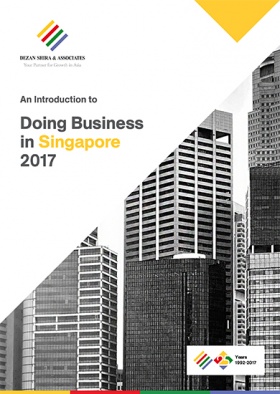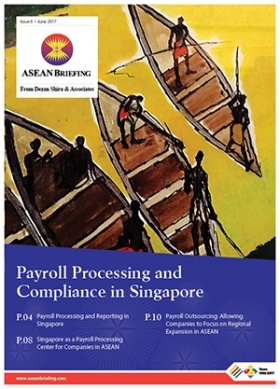IP Considerations for the ICT Industry in Singapore
The Information and Communication Technology (ICT) industry is a key pillar of Singapore’s economy as the country has positioned itself as an ICT hub for South East Asia; it is in fact a regional base for known multinationals such as Microsoft, Oracle, Amazon Web, Google, Twitter as well as various other international technology start-up companies. Given the Government’s recent push to transform Singapore into a Smart Nation, the country is expected to offer many promising business opportunities to Western SMEs, whose expertise and top-notch technology are highly sought after.
European SMEs engaged in cyber security technologies and services can benefit from the increased investments in cyber security as Singapore’s economy continues its progress on digitization. SMEs with products, technologies and solutions in the areas of big data, cloud computing, internet of things (IoT), ICT and sustainability, communications of the future, social media, new digital economy and user interfaces are also expected to find promising business opportunities in Singapore over the next three to five years, as these areas will receive the lion’s share of investments in the ICT sector.
European ICT companies should, however, pay attention to protecting their IP, because IP infringements still exist in Singapore. Well-managed IP is often a key factor for business success and neglecting to register IP rights in Singapore could easily end their business endeavor in the country. Thus, a comprehensive IPR strategy is needed, when entering Singapore’s market.Apply for patents to protect your inventions
ICT companies, wishing to market new inventions in Singapore, should consider applying for patents, because patent owners acquire, for a fixed period, the exclusive right to prevent others from using, commercializing or importing the patented inventions. It should also be kept in mid that patent rights are territorial, meaning that patents granted in Europe are not protected or recognized in Singapore.
Unlike most countries in ASEAN, there is only one official type of patent in Singapore – standard invention patent. In order to obtain a standard invention patent, an invention must satisfy the criteria of showing ‘novelty’, having an ‘inventive step’ and ‘industrial applicability’. Invention patents are valid for 20 years after the filing date and it usually takes from one to 4fouryears to obtain a patent. Because of the relatively long duration to obtain it, patents are most suitable for the ICT products with longer life-cycles.
Singapore is a member of the Paris Convention and the Patent Cooperation Treaty (PCT), which means that applicants for patents are entitled to a ‘right of priority’ (i.e. the same filing date the original application made in the home country can be used in Singapore), if the same filing is made in Singapore within 12 months from the first filing in any other country that also belongs to the Paris Convention. When using the PCT Route, the same filing must be made in Singapore within 30 months from the first filed application.
In Singapore, integrated circuit layout designs are also protected under the patent laws and regulations. As integrated circuits play a central role in the ICT industry, SMEs focused on R&D might also want to protect their integrated circuit layout designs. Integrated circuit layout designs are protected for a duration of 10 years if they are first used commercially within five years of creation. In any other case, they are protected for 15 years from the date of creation. Similar to patents, integrated circuit layout design protection also functions under the ‘first-to-file system’ and thus it is essential to apply for these rights already before entering Singapore’s market.
Registered designs protect the appearance of your product
Registered designs are increasingly used in the ICT industry to protect the appearance of products, like smart phones, tablets, and media players. Registered designs protect the aesthetic aspects of products, but not their functionalities.
To qualify for registration, designs must be ‘new’ (i.e. not yet published or disclosed to the public) at the time of the application. Therefore, SMEs should ensure that their design is not disclosed to others unless an application has been filed. Designs must also be industrially applicable.
SMEs should keep in mind that registered designs also function under a ‘first-to-file’ system. This means that if someone files an application on the design first, any similar or identical registered design which European SMEs wish to obtain will be in danger of being revoked for lack of ‘novelty’. It is therefore advisable to make applications as early as possible.
Good news for the ICT companies is that, in Singapore, unlike in many other South-East Asian countries, it is also possible to apply for a registered design that covers the Graphical User Interface (GUI). Given the central role of GUIs in ICT sector and the fierce competition on Singapore’s ICT market, it is important that GUI owners apply for the design patent in order to protect their inventions.
In Singapore, one of the requirements to obtain registered design for the GUI is industrial applicability. In order to satisfy this, GUIs must be applied to an article by any industrial process. Meaning that when applying for a registered design for the GUI, the applicant also needs to indicate the article that the GUI is applied to (e.g. the smartphone). As to the designs for products with GUIs, the applicant should submit drawings or photographs that clearly depict the design for which protection is sought. Therefore, the drawings or photographs submitted should contain the view(s) of the overall product indicating the location of the GUI.
Copyright protects the expression of SMEs’ ideas
Since the ICT sector features cumulative innovations with short product cycles, SMEs may wish to also take advantage of other IP rights, such as copyrights. One of the main values of copyright protection is simplicity, as copyright protection arises automatically as soon as the work is created. However, copyright protection extends only to expressions of ideas, and not to ideas per se.
In Singapore, works that qualify for copyright protection under the Copyright Act do not need to be registered in the country as copyright protection is conferred automatically to the author as soon as the creative work is expressed or fixed in a material form from which it is then capable of being reproduced. Copyright is protected for 70 years from the year in which the author died. What matters most to the ICT companies, is that source codes of computer programs are also protected under the copyright law in Singapore. In case of a copyright, however, it is prudent to clearly determine the ownership, as without evidence to the contrary, the person or entity whose name appears on the work will be deemed the copyright owner of the work.
Guard your Trade Secrets
The importance of trade secret protection cannot be overemphasized in high-tech companies. By protecting trade secrets, most businesses can take advantage of the lead time, meaning the ability to commercialize the innovation well ahead of competitors, so that substantial revenue can be captured before copycats are introduced in the market. This is especially helpful for companies with products that are expected to have a short run in the market like many ICT products.
Trade secrets are protected under Singaporean law. However, the trade secret must be ‘confidential’, meaning that the information is not freely available in the public domain. In cases of infringement, SMEs must also be able to prove that an obligation of confidence was clearly stated during dealings with third parties, such as by signing nondisclosure agreements or having a confidentiality clause within their agreements with other parties. Without the proof that third parties were aware of the obligation of confidentiality, trade secret enforcement would be impossible.
SMEs, wishing to relay on trade secrets to protect their top-notch technology, should include confidentiality clauses within employee contracts covering not only the duration of employment, but if possible, even after the employee has left. It should also be of paramount importance to ensure that confidentiality agreements are signed with business partners whenever disclosing confidential information.
Don’t Forget to Protect your Brand
Considering that ICT products tend to have shorter product cycles, and at the same time, improvements are added at a consistent pace, SMEs will benefit from consistent branding. Since there is a strong interaction and interoperability among ICT products in the market, having a consistent source identifier would be useful to drive business value. Along with the branding strategy, it is essential to undertake the protection of such brands through trade mark registration.
Like patents and registered designs, trade mark registration also functions under the ‘first-to-file’ rule in Singapore and early applications for trade marks, ideally before the release of products into the market, is recommended.
Although unregistered trade marks may still be protected under the common law tort of ‘passing off’ in Singapore, registration is highly recommended for a more straight forward and comprehensive protection. The law of ‘passing off’ essentially prevents other traders from unfairly benefiting from the goodwill that that has been built up by a trader. Three factors need to be proved before a claim of passing off can succeed:
- That the original user of the mark has established goodwill for the trade mark within Singapore;
- That the defendant’s conduct has lead the public to believe that his goods or services are goods or services of the plaintiff (this is usually referred to as the Misrepresentation element); and
- As a result of the misrepresentation, the original user has suffered damage.
Since the legal remedies available in such a case are more limited than if the mark had been registered, it is advisable for SMEs to register their trade mark in Singapore. Trade marks are registered with the Intellectual Property Office of Singapore (IPOS) and it usually takes six to nine months to register a trade mark in Singapore if no opposition is presented.
About South-East Asia IPR SME Helpdesk
The South-East Asia IPR SME Helpdesk supports small and medium sized enterprises (SMEs) from European Union (EU) member states to protect and enforce their Intellectual Property Rights (IPR) in or relating to South-East Asian countries, through the provision of free information and services. The Helpdesk provides jargon-free, first-line, confidential advice on intellectual property and related issues, along with training events, materials and online resources. Individual SMEs and SME intermediaries can submit their IPR queries via email (question@southeastasia-iprhelpdesk.eu) and gain access to a panel of experts, in order to receive free and confidential first-line advice within 3 working days.
The South-East Asia IPR SME Helpdesk is co-funded by the European Union.
To learn more about the South-East Asia IPR SME Helpdesk and any aspect of intellectual property rights in South-East Asia, please visit our online portal at http://www.ipr-hub.eu/.
About Us
ASEAN Briefing is produced by Dezan Shira & Associates. The firm assists foreign investors throughout Asia and maintains offices throughout ASEAN, including in Singapore, Hanoi, Ho Chi Minh City and Jakarta. Please contact us at asia@dezshira.com or visit our website at www.dezshira.com.
- Previous Article Singapore’s Rising FinTech Sector
- Next Article L’Indonésie Relâche son Ratio Prêt-Valeur pour Inciter la Croissance des Prêts Bancaires









